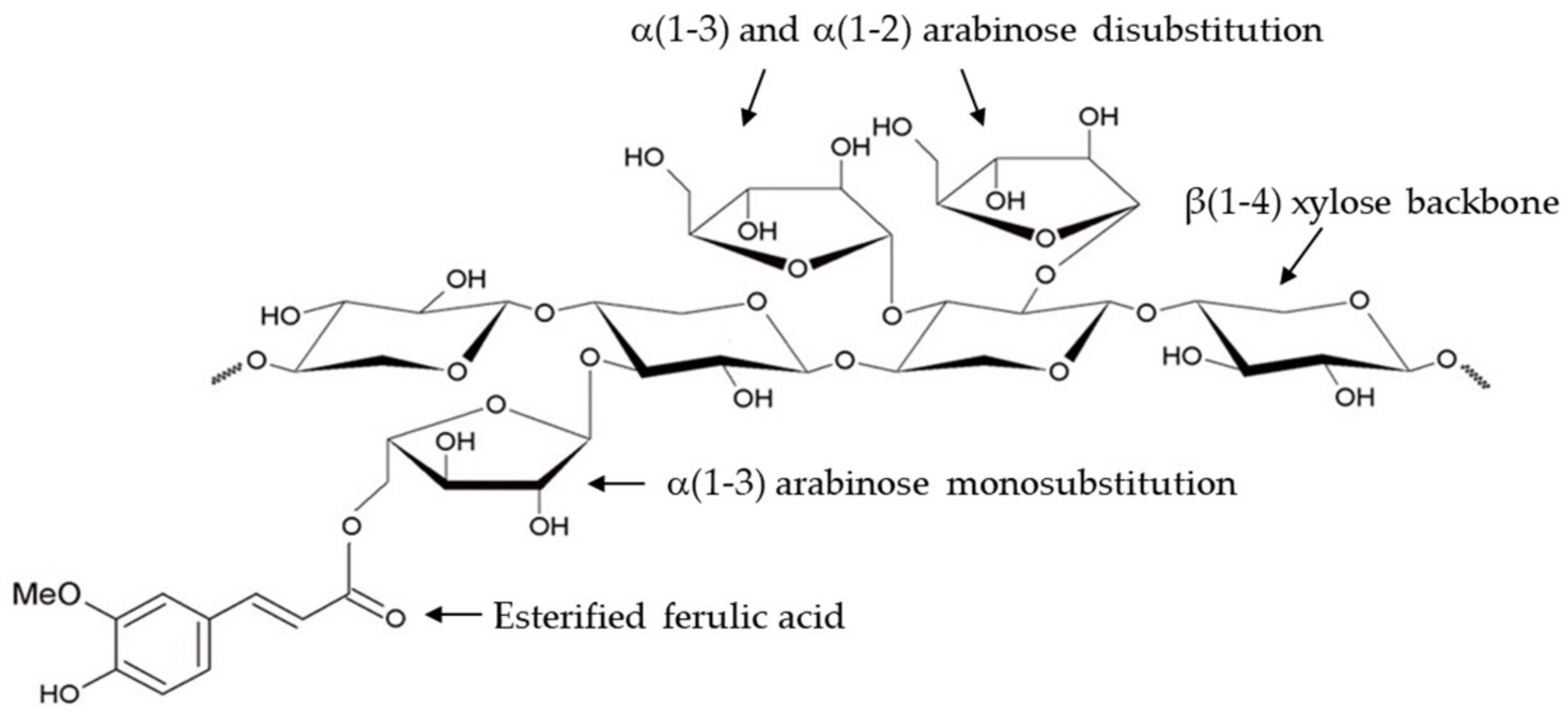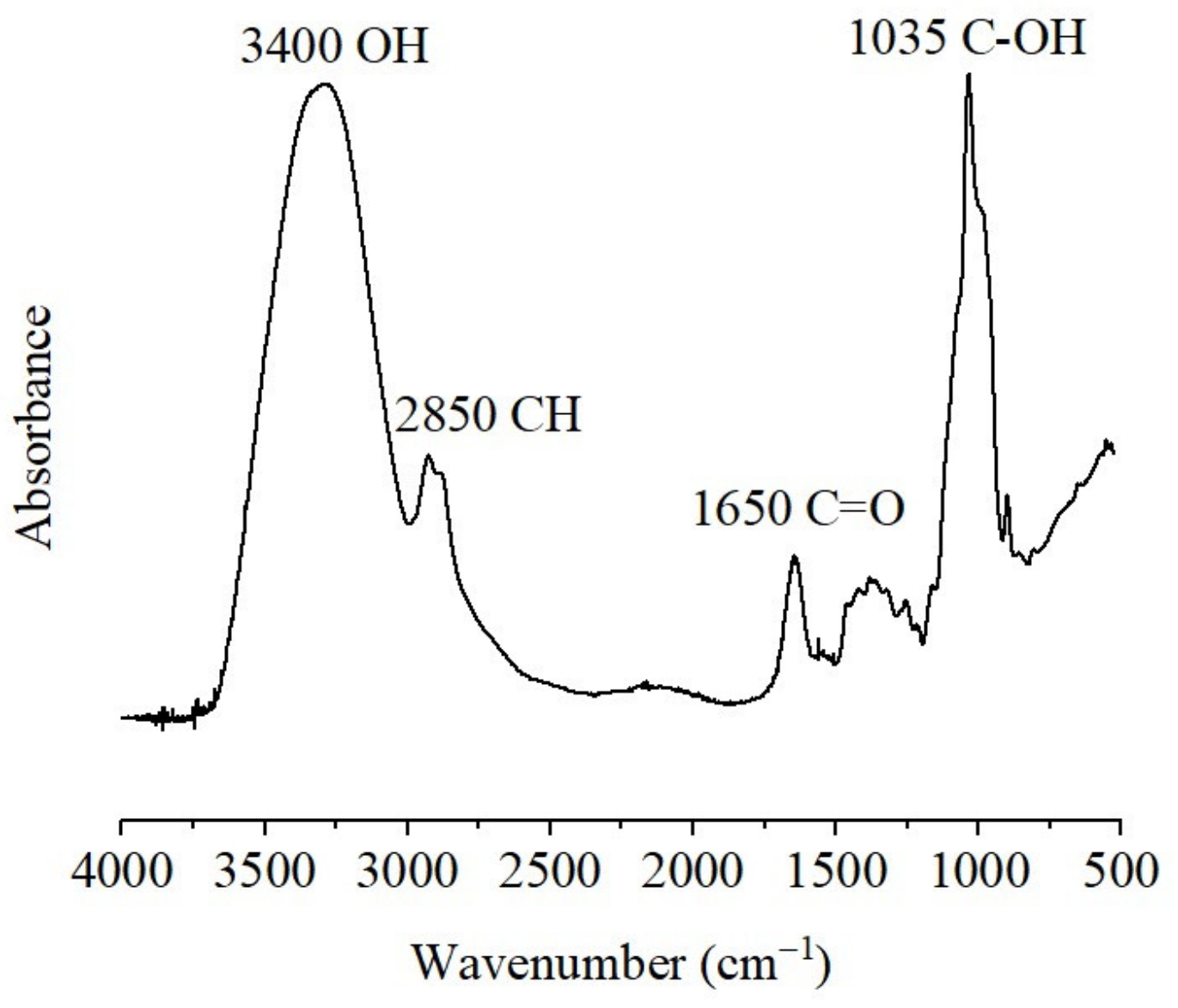Fabrication and Characterization of Ferulated Water-Extractable Arabinoxylan Electrospun Nanofibers
Abstract
1. Introduction
2. Materials and Methods
2.1. Arabinoxylan (AX) Source
2.2. AX Characterization
2.3. Fabrication of Electrospun Nanofibers
2.4. Characterization of Electrospun AX Nanofibers
2.5. Statistical Analysis
3. Results
3.1. AX Characteristics
3.2. Electrospun Nanofibers
3.3. Characteristics of Electrospun AX Nanofibers
4. Discussion
5. Conclusions
Author Contributions
Funding
Data Availability Statement
Acknowledgments
Conflicts of Interest
References
- Marquez-Escalante, J.; Carvajal-Millan, E.; Martínez-López, A.; Martinez Robinson, K.; Campa-Mada, A.; Rascon, A. Fine structural features and antioxidant capacity of ferulated arabinoxylans extracted from nixtamalized maize bran. J. Sci. Food Agric. 2023, 103, 4584–4591. [Google Scholar] [CrossRef] [PubMed]
- Aminzadeh, S.; Zhang, L.; Henriksson, G. A possible explanation for the structural inhomogeneity of lignin in LCC networks. Wood Sci. Technol. 2017, 51, 1365–1376. [Google Scholar] [CrossRef]
- Mendez-Encinas, M.A.; Carvajal-Millan, E.; Rascon-Chu, A.; Astiazaran-Garcia, H.F.; Valencia-Rivera, D.E. Ferulated Arabinoxylans and Their Gels: Functional Properties and Potential Application as Antioxidant and Anticancer Agent. Oxidative Med. Cell. Longev. 2018, 2018, 2314759. [Google Scholar] [CrossRef]
- Pietiäinen, S.; Moldin, A.; Ström, A.; Malmberg, C.; Langton, M. Effect of physicochemical properties, pre-processing, and extraction on the functionality of wheat bran arabinoxylans in breadmaking—A review. Food Chem. 2022, 383, 132584. [Google Scholar] [CrossRef]
- Kaur, A.; Yadav, M.P.; Singh, B.; Bhinder, S.; Simon, S.; Singh, N. Isolation and characterization of arabinoxylans from wheat bran and study of their contribution to wheat flour dough rheology. Carbohydr. Polym. 2019, 221, 166–173. [Google Scholar] [CrossRef]
- Schupfer, E.; Pak, S.C.; Wang, S.Y.; Micalos, P.S.; Jeffries, T.; Ooi, S.L.; Golombick, T.; Harris, G.; El-Omar, E. The effects and benefits of arabinoxylans on human gut microbiota—A narrative review. Food Biosci. 2021, 43, 101267. [Google Scholar] [CrossRef]
- Kamel, R.; Afifi, S.M.; Kassem, I.A.A.; Elkasabgy, N.A.; Farag, M.A. Arabinoxylan and rhamnogalacturonan mucilage: Outgoing and potential trends of pharmaceutical, environmental, and medicinal merits. Int. J. Biol. Macromol. 2020, 165, 2550–2564. [Google Scholar] [CrossRef]
- Aduba, D.C.; An, S.-S.; Selders, G.S.; Yeudall, W.A.; Bowlin, G.L.; Kitten, T.; Yang, H. Electrospun gelatin–arabinoxylan ferulate composite fibers for diabetic chronic wound dressing application. Int. J. Polym. Mater. Polym. Biomater. 2019, 68, 660–668. [Google Scholar] [CrossRef]
- Duan, J.; Karaaslan, M.A.; Cho, M.; Liu, L.-Y.; Johnson, A.M.; Renneckar, S. Investigation into electrospinning water-soluble xylan: Developing applications from highly absorbent and hydrophilic surfaces to carbonized fiber. Cellulose 2019, 26, 413–427. [Google Scholar] [CrossRef]
- Butylina, S.; Koljonen, K.; Hiltunen, S.; Laatikainen, K. Study on spinnability of arabinoxylan extracted from barley husks. Cellulose 2022, 29, 8409–8425. [Google Scholar] [CrossRef]
- Morales-Ortega, A.; Carvajal-Millan, E.; López-Franco, Y.; Rascón-Chu, A.; Lizardi-Mendoza, J.; Torres-Chavez, P.; Campa-Mada, A. Characterization of Water Extractable Arabinoxylans from a Spring Wheat Flour: Rheological Properties and Microstructure. Molecules 2013, 18, 8417–8428. [Google Scholar] [CrossRef] [PubMed]
- Rodríguez-León, E.; Íñiguez-Palomares, R.A.; Navarro, R.E.; Rodríguez-Beas, C.; Larios-Rodríguez, E.; Alvarez-Cirerol, F.J.; Íñiguez-Palomares, C.; Ramírez-Saldaña, M.; Hernández Martínez, J.; Martínez-Higuera, A.; et al. Silver nanoparticles synthesized with Rumex hymenosepalus extracts: Effective broad-spectrum microbicidal agents and cytotoxicity study. Artif. Cells. Nanomed. Biotechnol. 2018, 46, 1194–1206. [Google Scholar] [CrossRef] [PubMed]
- Kale, M.S.; Yadav, M.P.; Hicks, K.B.; Hanah, K. Concentration and shear rate dependence of solution viscosity for arabinoxylans from different sources. Food Hydrocoll. 2015, 47, 178–183. [Google Scholar] [CrossRef]
- Burgara-Estrella, A.J.; Acosta-Elias, M.A.; Álvarez-Bajo, O.; Silva-Campa, E.; Angulo-Molina, A.; Rodríguez-Hernández, I.d.C.; Sarabia-Sainz, H.M.; Escalante-Lugo, V.M.; Pedroza-Montero, M.R. Atomic force microscopy and Raman spectra profile of blood components associated with exposure to cigarette smoking. RSC Adv. 2020, 10, 11971–11981. [Google Scholar] [CrossRef]
- Yuan, C.; Chen, M.; Zhu, K.; Ni, J.; Wang, S.; Cao, B.; Zhong, S.; Zhou, J.; Wang, S. Facile synthesis of nitrogen-doped interconnected porous carbons derived from reed and chlorella for high-performance supercapacitors. Fuel Process. Technol. 2022, 238, 107466. [Google Scholar] [CrossRef]
- Dervilly-Pinel, G.; Thibault, J.-F.; Saulnier, L. Experimental evidence for a semiflexible conformation for arabinoxylans. Carbohydr. Res. 2001, 330, 365–372. [Google Scholar] [CrossRef]
- Picout, D.R.; Ross-Murphy, S.B. On the chain flexibility of arabinoxylans and other β-(1→4) polysaccharides. Carbohydr. Res. 2002, 337, 1781–1784. [Google Scholar] [CrossRef]
- De Anda-Flores, Y.; Carvajal-Millan, E.; Lizardi-Mendoza, J.; Rascon-Chu, A.; Martínez-López, A.L.; Marquez-Escalante, J.; Brown-Bojorquez, F.; Tanori-Cordova, J. Covalently Cross-Linked Nanoparticles Based on Ferulated Arabinoxylans Recovered from a Distiller’s Dried Grains Byproduct. Processes 2020, 8, 691. [Google Scholar] [CrossRef]
- Sarker, N.C.; Ray, P.; Pfau, C.; Kalavacharla, V.; Hossain, K.; Quadir, M. Development of Functional Nanomaterials from Wheat Bran Derived Arabinoxylan for Nucleic Acid Delivery. J. Agric. Food Chem. 2020, 68, 4367–4373. [Google Scholar] [CrossRef]
- Kang, J.; Guo, Q.; Shi, Y.C. Molecular and conformational properties of hemicellulose fiber gum from dried distillers grains with solubles. Food Hydrocoll. 2018, 80, 53–59. [Google Scholar] [CrossRef]
- Son, W.K.; Youk, J.H.; Lee, T.S.; Park, W.H. The effects of solution properties and polyelectrolyte on electrospinning of ultrafine poly(ethylene oxide) fibers. Polymer 2024, 45, 2959–2966. [Google Scholar] [CrossRef]
- Keirouz, A.; Wang, Z.; Reddy, V.S.; Nagy, Z.K.; Vass, P.; Buzgo, M.; Ramakrishna, S.; Radacsi, N. The history of electrospinning: Past, present, and future developments. Adv. Mater. Technol. 2023, 8, 2201723. [Google Scholar] [CrossRef]
- Amariei, N.; Manea, L.R.; Bertea, A.P.; Bertea, A.; Popa, A. The Influence of Polymer Solution on the Properties of Electrospun 3D Nanostructures. IOP Conf. Ser. Mater. Sci. Eng. 2017, 209, 012092. [Google Scholar] [CrossRef]
- Salvada, J.; Alke, B.; Brazinha, C.; Alves, V.D.; Coelhoso, I.M. Development and Characterisation of Arabinoxylan-Based Composite Films. Coatings 2022, 12, 813. [Google Scholar] [CrossRef]
- Yue, Y.-K.; Yang, Z.; Xing, J.-J.; Guo, X.-N.; Zhu, K.-X. Fabrication and stabilization mechanisms of Pickering emulsions based on gliadin/arabinoxylan complexes. Food Chem. 2022, 393, 133458. [Google Scholar] [CrossRef]
- Okutan, N.; Terzi, P.; Altay, F. Affecting parameters on electrospinning process and characterization of electrospun gelatin nanofibers. Food Hydrocoll. 2014, 39, 19–26. [Google Scholar] [CrossRef]
- Song, J.H.; Kim, H.E.; Kim, H.W. Production of electrospun gelatin nanofiber by water-based co-solvent approach. J. Mater. Sci. Mater. Med. 2008, 19, 95–102. [Google Scholar] [CrossRef]
- Erencia, M.; Cano, F.; Tornero, J.A.; Macanás, J.; Carrillo, F. Resolving the electrospinnability zones and diameter prediction for the electrospinning of the gelatin/water/acetic acid system. Langmuir 2014, 30, 7198–7205. [Google Scholar] [CrossRef]
- Stie, M.B.; Jones, M.; Sørensen, H.O.; Jacobsen, J.; Chronakis, I.S.; Nielsen, H.M. Acids ‘generally recognized as safe’ affect morphology and biocompatibility of elec-trospun chitosan/polyethylene oxide nanofibers. Carbohydr. Polym. 2019, 215, 253–262. [Google Scholar] [CrossRef]
- Kamalpour, R.; Koocheki, A.; Ghorani, B. Encapsulation of D-limonene in Lepidium perfoliatum seed gum/PVA electrospun nanofibers: Physicochemical characterization and modeling the kinetics of release. Curr. Res. Food Sci. 2025, 10, 100966. [Google Scholar] [CrossRef]
- Tayebi-Khorrami, V.; Shahgordi, S.; Mahdi Dabbaghi, M.; Saleh Fadaei, M.; Masoumi Shahrbabak, S.; Fallahianshafiei, S.; Reza Fadaei, M.; Saquib Hasnain, M.; Kumar Nayak, A.; Reza Askari, V. From nature to nanotech: Harnessing the power of electrospun polysaccharide-based nanofibers as sustainable packaging. Int. J. Biol. Macromol. 2025, 299, 140127. [Google Scholar] [CrossRef] [PubMed]










| Characteristic | Value |
|---|---|
| Mw (kDa) | 769 |
| I (Mw/Mn) | 3.2 |
| [η] (dL/g) | 4.51 |
| RG (nm) | 55 |
| Rh | 31 |
| C∞ | 10.7 |
| q (nm) | 3.2 |
| Mark–Houwink–Sakurada α | 0.31 |
| Mark–Houwink–Sakurada K (mL/g) | 9.4 |
| Solvent | AX Concentration (% w/v) | Flow (mL/h) | Ejection Form | Material Obtained |
|---|---|---|---|---|
| Water | 3.5 | 0.3 | Droplets | Liquid |
| Water | 6.0 | 1.2 | Aspersion | Film |
| Ethanol (40% v/v) * | 3.5 | 0.3 | Taylor cone | Film |
| Ethanol (40% v/v) * | 6.0 | 1.2 | Aspersion | Liquid |
| Acetic acid (50% v/v) * | 3.5 | 0.3 | Aspersion | Film |
| Acetic acid (50% v/v) * | 6.0 | 0.3 | Taylor cone | Nanofibers |
Disclaimer/Publisher’s Note: The statements, opinions and data contained in all publications are solely those of the individual author(s) and contributor(s) and not of MDPI and/or the editor(s). MDPI and/or the editor(s) disclaim responsibility for any injury to people or property resulting from any ideas, methods, instructions or products referred to in the content. |
© 2025 by the authors. Licensee MDPI, Basel, Switzerland. This article is an open access article distributed under the terms and conditions of the Creative Commons Attribution (CC BY) license (https://creativecommons.org/licenses/by/4.0/).
Share and Cite
Robles-Ceceña, M.; Rascón-Chu, A.; Miranda-Arizmendi, V.; Burgara-Estrella, A.J.; Castillo, S.J.; Mora-Monroy, R.; Brown-Bojorquez, F.; Lizardi-Mendoza, J.; Maldonado-Arce, A.D.; Carvajal-Millan, E. Fabrication and Characterization of Ferulated Water-Extractable Arabinoxylan Electrospun Nanofibers. Polysaccharides 2025, 6, 32. https://doi.org/10.3390/polysaccharides6020032
Robles-Ceceña M, Rascón-Chu A, Miranda-Arizmendi V, Burgara-Estrella AJ, Castillo SJ, Mora-Monroy R, Brown-Bojorquez F, Lizardi-Mendoza J, Maldonado-Arce AD, Carvajal-Millan E. Fabrication and Characterization of Ferulated Water-Extractable Arabinoxylan Electrospun Nanofibers. Polysaccharides. 2025; 6(2):32. https://doi.org/10.3390/polysaccharides6020032
Chicago/Turabian StyleRobles-Ceceña, Manuel, Agustín Rascón-Chu, Valeria Miranda-Arizmendi, Alexel J. Burgara-Estrella, Santos J. Castillo, Roberto Mora-Monroy, Francisco Brown-Bojorquez, Jaime Lizardi-Mendoza, Amir D. Maldonado-Arce, and Elizabeth Carvajal-Millan. 2025. "Fabrication and Characterization of Ferulated Water-Extractable Arabinoxylan Electrospun Nanofibers" Polysaccharides 6, no. 2: 32. https://doi.org/10.3390/polysaccharides6020032
APA StyleRobles-Ceceña, M., Rascón-Chu, A., Miranda-Arizmendi, V., Burgara-Estrella, A. J., Castillo, S. J., Mora-Monroy, R., Brown-Bojorquez, F., Lizardi-Mendoza, J., Maldonado-Arce, A. D., & Carvajal-Millan, E. (2025). Fabrication and Characterization of Ferulated Water-Extractable Arabinoxylan Electrospun Nanofibers. Polysaccharides, 6(2), 32. https://doi.org/10.3390/polysaccharides6020032









